Welcome to Quetzaltenango! This region of Guatemala is known for its stunning mountain landscapes, but it is also home to an incredible variety of birds. From the brightly colored Quetzal to the loud-mouthed Toucan, there are over 400 species of birds living in Quetzaltenango.
Visitors can catch a glimpse of these feathered friends while exploring the city’s parks, forests, and other natural areas. From the majestic Resplendent Quetzal to the tiny hummingbird, there are many birds to observe and admire in Quetzaltenango.
Whether you are a beginner or an experienced birdwatcher, you are sure to enjoy the wide variety of birds in Quetzaltenango.
1. Resplendent Quetzal
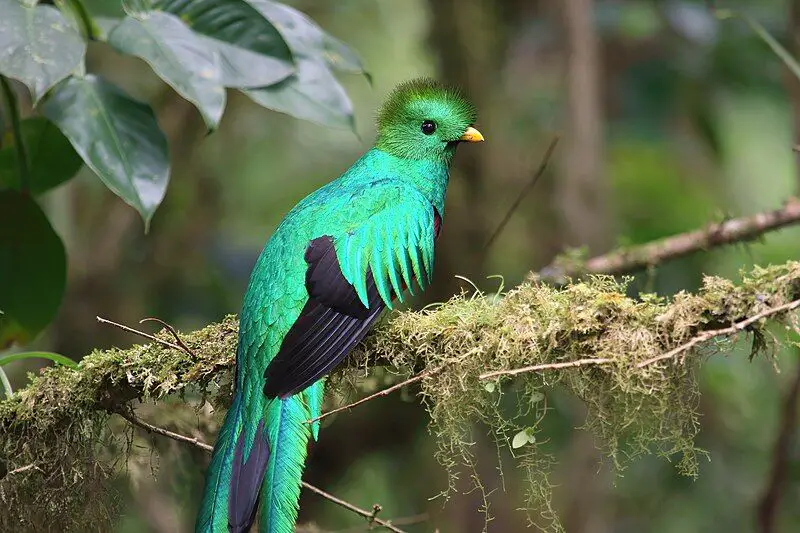
The resplendent quetzal is a magnificent species of bird found in tropical forests in southern Mexico and Central America. It is a member of the family Trogonidae, and two subspecies are recognized: P. m. mocinno and P. m. costaricensis.
The quetzal prefers the dense, lush vegetation of montane cloud forests, where it can feed and breed in peace.
It is a colorful bird, with green, red, and blue feathers, and a long, elegant tail. The resplendent quetzal is a unique and beloved species in southern Mexico and Central America and is the national bird of Guatemala.
It is renowned for its beauty and is featured on coins, stamps, and artwork. Its status as a cultural symbol has led to increased conservation efforts to protect its habitat and population.
Unfortunately, their numbers are declining due to human activities such as deforestation and hunting. It is therefore important to ensure that their habitat is safe and that they can continue to thrive in the wild.
| Kingdom | Animalia |
| Phylum | Chordata |
| Class | Aves |
| Order | Trogoniformes |
| Family | Trogonidae |
| Genus | Pharomachrus |
| Species | P. mocinno |
2. Hummingbirds
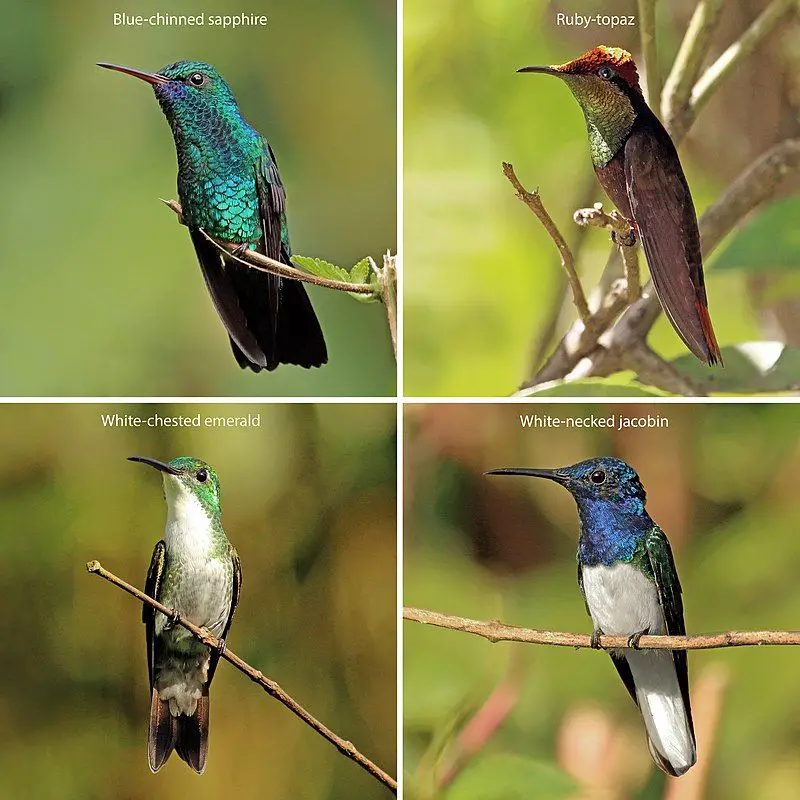
Hummingbirds are a fascinating bird species that are native to the Americas. They belong to the scientific family Trochilidae, which is made up of over 366 species and 113 genera.
Hummingbirds can be found in many places across the Americas, from Alaska to Tierra del Fuego, but the majority of species are concentrated in Central and South America. Hummingbirds are best known for their ability to hover in the air while making a distinctive humming sound.
This is due to their rapid wing beats, which can reach up to 80 beats per second.
The wings are also adapted for rapid maneuvering, allowing them to dodge and dart through the air with great agility. The diet of hummingbirds consists mainly of nectar, which they feed on using their long beaks and tongues.
They also feed on small insects and spiders, which they catch in the air.
Hummingbirds also have an incredibly fast metabolism, which allows them to consume a large amount of food in a small amount of time. Hummingbirds are also important pollinators, as they move from flower to flower in search of nectar.
As they do so, they spread pollen across the landscape, helping to keep plants healthy and diverse. Hummingbirds are an important and fascinating part of the natural world, and they play an important role in the ecosystems of the Americas.
They are a unique bird species that is well worth studying and appreciating.
| Kingdom | Animalia |
| Phylum | Chordata |
| Class | Aves |
| Clade | Strisores |
| Order | Apodiformes |
| Family | Trochilidae |
3. Great Curassow
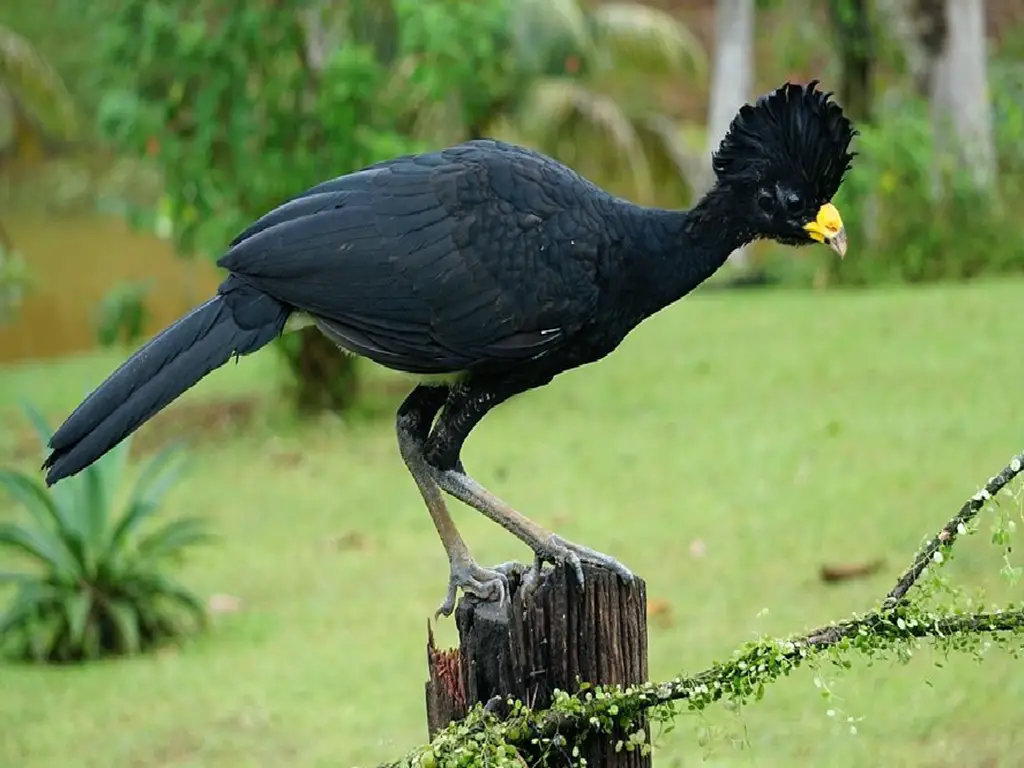
The great curassow is a species of large, pheasant-like bird that inhabits the Neotropical rainforests, from eastern Mexico to western Colombia and northwestern Ecuador.
Male great curassows are easily distinguished by their black feathers and yellow beaks, as well as their curly crests. Females of this species come in three different color morphs, being barred, rufous, and black.
As a species, the great curassow has an impressive range, spanning from eastern Mexico to western Colombia and northwestern Ecuador, providing them with a variety of habitats to thrive in.
They are found in all types of Neotropical rainforests, from the humid lowlands to the mountainous regions. Furthermore, their diet consists of fruits, seeds, insects, and other small animals.
As a result, they have become an important part of the Neotropical rainforest ecosystem, aiding in the dispersal of seeds and the pollination of flowers.
| Kingdom | Animalia |
| Phylum | Chordata |
| Class | Aves |
| Order | Galliformes |
| Family | Cracidae |
| Genus | Crax |
| Species | C. rubra |
4. Limpkin

The limpkin is a unique bird found in warm regions of the Americas, from Florida to northern Argentina. It is the only species in its family, Aramidae, and is related to rails and cranes.
It has several nicknames, such as Carrao, courlan, and Crying Bird, and is easily recognizable by its loud call. The limpkin prefers to frequent wetlands, but it has been known to occasionally make its way as far north as Wisconsin.
It is a large bird, with a wingspan of up to 25 inches and a weight of up to three pounds. The plumage is typically brownish-gray with a white or yellowish bill.
The limpkin has been known to feed on snails, mussels, and other aquatic invertebrates, as well as frogs, fish, and small snakes.
Its population is believed to be decreasing in some areas due to habitat destruction, and it is listed as a species of concern in some parts of its range.
| Kingdom | Animalia |
| Phylum | Chordata |
| Class | Aves |
| Order | Gruiformes |
| Family | Aramidae |
| Genus | Aramus |
| Species | A. guarauna |
5. Pink-headed Warbler
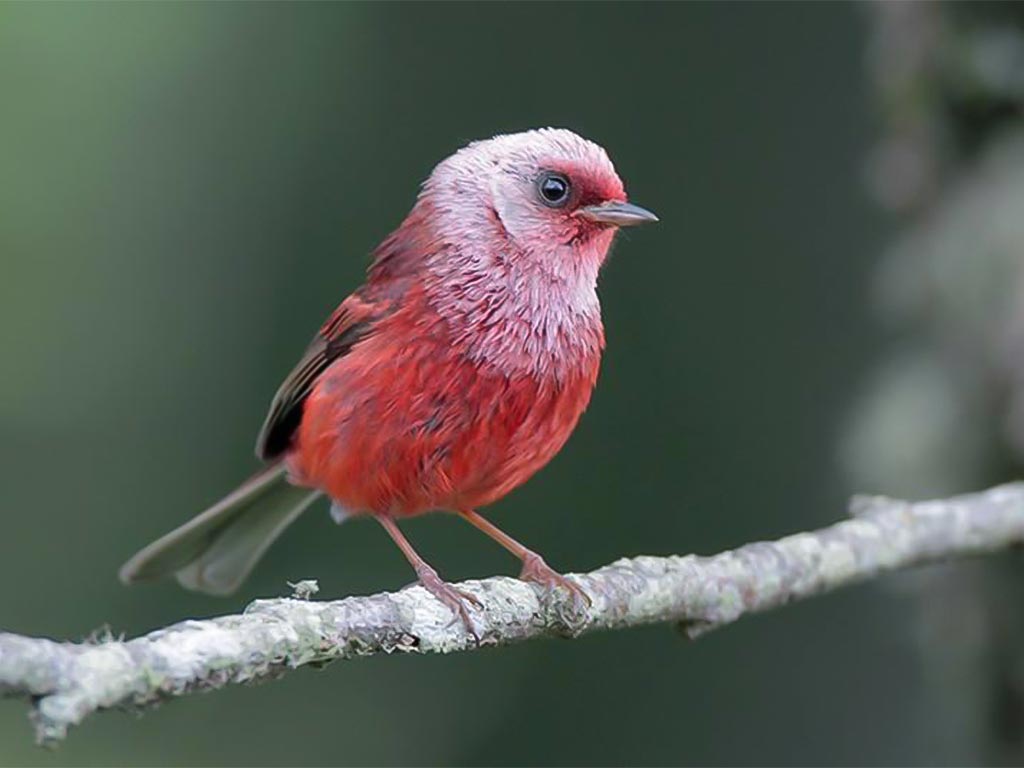
The pink-headed warbler is a small species of passerine bird found in the southwestern highlands of Guatemala and the central and southeastern highlands of the Mexican state of Chiapas.
This species of bird is primarily red, with a unique silvery-pink color on its head and chest. It is a small species, measuring around 11 to 12 cm in length and weighing around 9 to 11 g. Its wingspan is also relatively small, measuring around 17 to 19 cm.
The pink-headed warbler has a slender body shape and a long tail, both of which are typical of passerine birds. The pink-headed warbler has a distinctive call that is described as a loud, trill-like twittering sound.
This species of bird is usually found in open areas with scattered trees and shrubs, such as pastures, fields, and secondary forests. They are also known to inhabit areas with dense thickets of trees and shrubs, as well as open, grassy areas.
They feed mainly on insects, as well as some fruits and seeds. The pink-headed warbler is considered to be an endangered species due to habitat loss and degradation. The destruction of its natural habitat has caused a drastic decline in its population numbers in recent years.
This has led to the species being listed as critically endangered by the IUCN Red List of Threatened Species. To protect this species and help boost its population numbers, conservation efforts have been implemented in many parts of its range.
These include measures such as habitat protection, and the creation of protected areas for the pink-headed warbler.
| Kingdom | Animalia |
| Phylum | Chordata |
| Class | Aves |
| Order | Passeriformes |
| Family | Parulidae |
| Genus | Cardellina |
| Species | C. versicolor |
6. Red-billed Pigeon
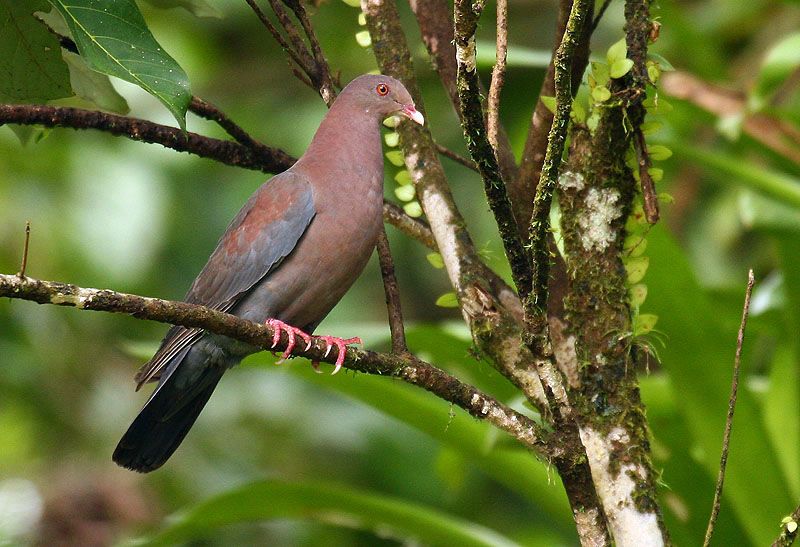
The red-billed pigeon is an impressive species of bird, known for its large size and robust physique. It is native to the United States, Mexico, and Central America, ranging from southern Texas to Costa Rica.
This impressive species of bird makes its home in a variety of habitats, including coastal areas and lowland regions. The red-billed pigeon is a common sight in these areas, often seen in flocks of dozens of birds.
They are known to fly in large formations, often in search of food or search of a new home. This species of bird has a unique diet, consisting of both insects and fruit.
The red-billed pigeon is an integral part of the ecosystem in its range, helping to keep the local insect population in check. As such, it is an important species to protect and conserve.
| Kingdom | Animalia |
| Phylum | Chordata |
| Class | Aves |
| Order | Columbiformes |
| Family | Columbidae |
| Genus | Patagioenas |
| Species | P. flavirostris |
7. Roseate Spoonbill
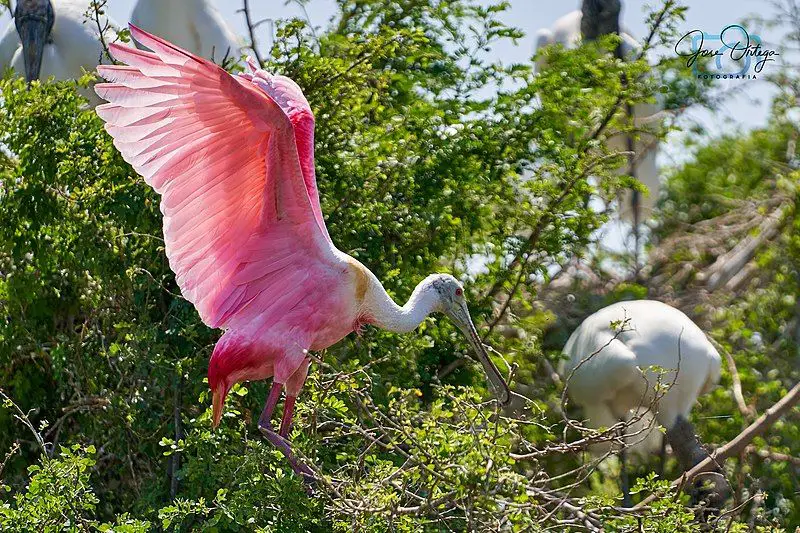
The roseate spoonbill is a unique wading bird that is part of the ibis and spoonbill family, Threskiornithidae. It is a migratory bird, with a large range that includes both South and North America.
It stands out from other birds in its family due to its unusual pink color, which is caused by a carotenoid pigment called canthaxanthin, the same pigment that is found in the American flamingo.
Spoonbills are gregarious, which means they tend to live in groups and feed together. They are also known to breed in colonies, favoring coastal marshes, mangroves, and lagoons as nesting sites.
The roseate spoonbill has a unique diet, consisting of small aquatic animals such as shrimp and crabs. They use their long, spoon-shaped bill to filter food from the water and feed by swinging their heads from side to side.
The diet of the roseate spoonbill is what gives it its unique pink color, which is why it is often mistaken for the American flamingo.
| Kingdom | Animalia |
| Phylum | Chordata |
| Class | Aves |
| Order | Pelecaniformes |
| Family | Threskiornithidae |
| Genus | Platalea |
| Species | P. ajaja |
8. Great Tinamou
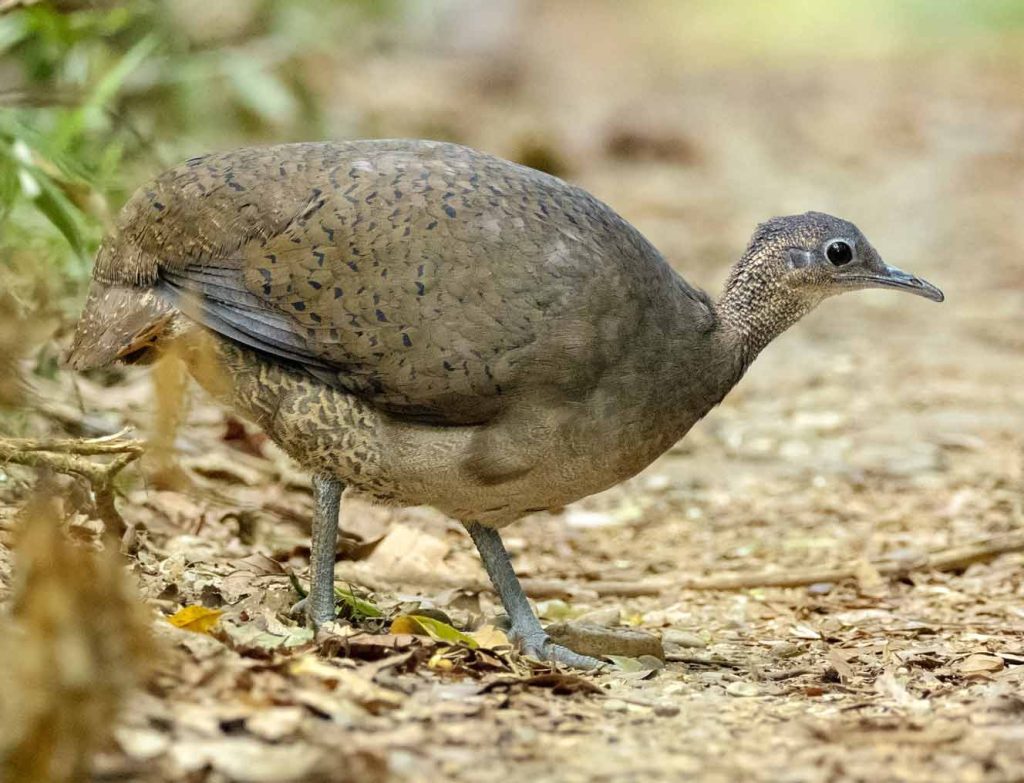
The great tinamou is a species of ground bird belonging to the tinamou family. It is native to Central and South America and is found in a range of habitats, including forests, shrublands, and grasslands.
There are several subspecies of the great tinamou, which are mostly differentiated by their coloration. For example, some great tinamous have a reddish-brown back with white underparts, while others have a gray-brown back and yellowish-brown underparts.
In addition, some subspecies have white stripes on their wings and tail feathers. The great tinamou is a medium-sized bird, reaching a length of up to 30 cm. It is a largely terrestrial species, and its diet consists mainly of small invertebrates, seeds, and fruits.
It is a vocal species, and its call is a loud, piercing whistle. The great tinamou is a widely distributed species, and its population is considered to be stable.
| Kingdom | Animalia |
| Phylum | Chordata |
| Class | Aves |
| Order | Tinamiformes |
| Family | Tinamidae |
| Genus | Tinamus |
| Species | T. major |
9. Plain Chachalaca
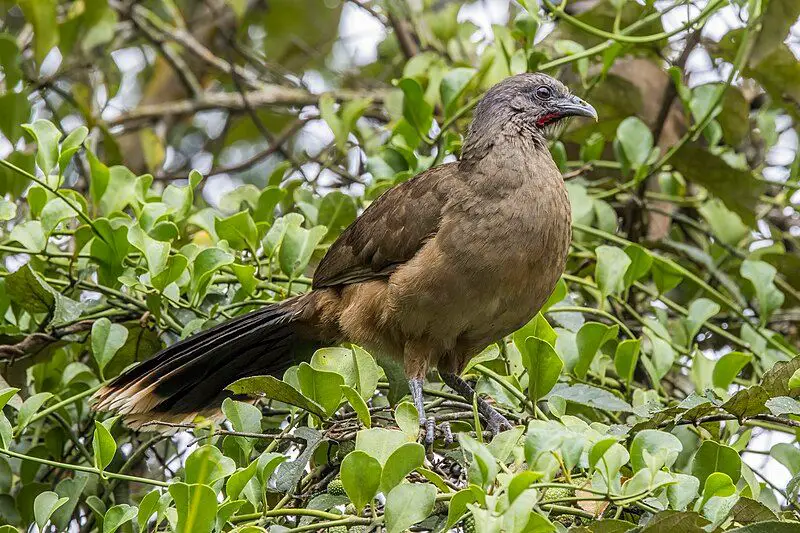
The plain chachalaca is a large bird native to the Americas, belonging to the family of birds known as Cracidae. This family includes guans and curassows, which are also large birds.
The plain chachalaca is found in tropical and subtropical regions, ranging from the Rio Grande Valley in southern Texas in the United States, all the way down to northern Costa Rica.
They are usually found in mesquite thickets, which are dense areas of shrubs, trees, and other vegetation. These birds are mainly found in low-lying areas, such as near rivers, ponds, and lakes. They are also sometimes found in the canopy of forests.
The plain chachalaca is a social bird, often found in small flocks, and it feeds on fruit, seeds, and other vegetation.
| Kingdom | Animalia |
| Phylum | Chordata |
| Class | Aves |
| Order | Galliformes |
| Family | Cracidae |
| Genus | Ortalis |
| Species | O. vetula |
10. Ornate Hawk-eagle
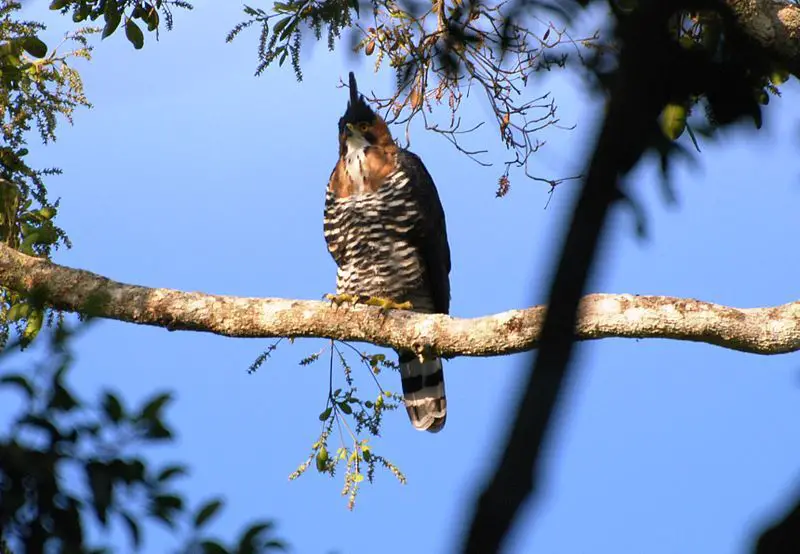
The ornate hawk-eagle is a species of bird of prey found in the tropical regions of the Americas. It is a fairly large bird, belonging to the family Accipitridae, which is a group of raptors that includes all species of eagles.
Its original scientific name was crested hawk-eagle, but this caused some confusion as that is the common name of another species of eagle found in Asia. To distinguish between the two species, the ornate hawk-eagle was given its current name.
All eagles have similar physical characteristics, such as hooked bills, powerful talons, and sharp eyesight. The ornate hawk-eagle, however, has a few unique features that make it stand out, such as a crest of feathers on its head and a brownish-red tail.
The ornate hawk-eagle is a solitary hunter, mainly relying on its sharp eyesight to spot prey from up high in the sky. It is an opportunistic hunter that feeds on a range of small animals, including reptiles, amphibians, small mammals, and other birds.
| Kingdom | Animalia |
| Phylum | Chordata |
| Class | Aves |
| Order | Accipitriformes |
| Family | Accipitridae |
| Genus | Spizaetus |
| Species | S. ornatus |
11. Horned Guan
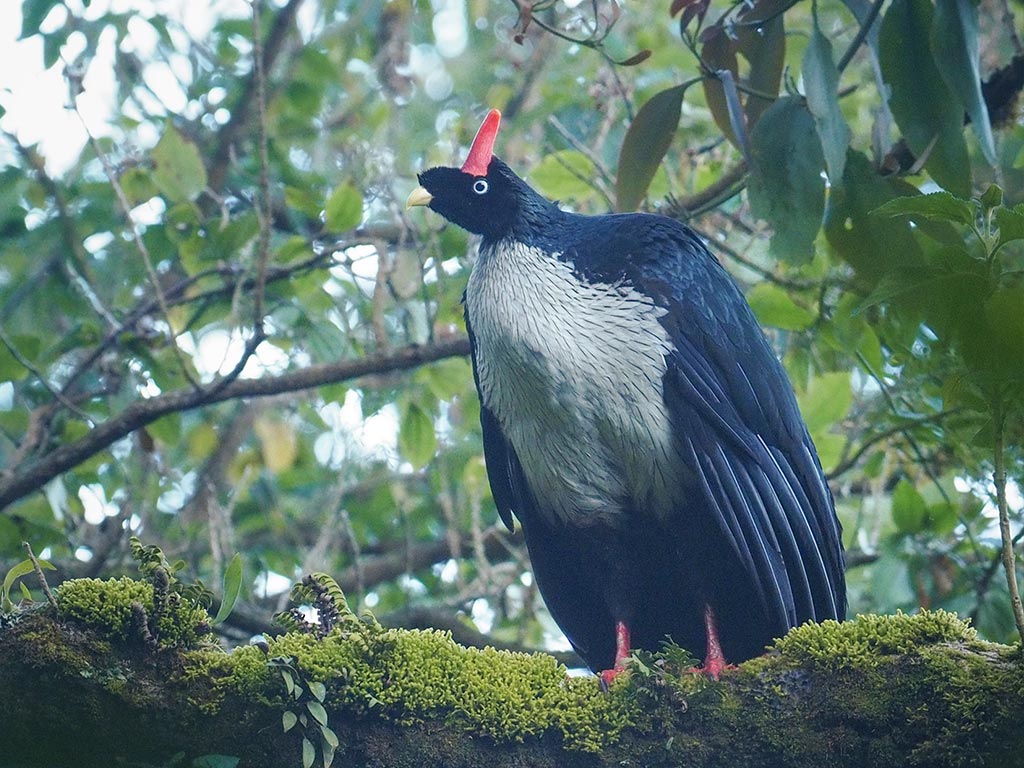
The horned guan is a unique bird that is found only in Central America. It belongs to the turkey family and is the only species in its genus, Oreophasis. It is a large bird, with a noticeable crest of feathers on its head.
This crest gives the bird its name, as it resembles a horn. The horned guan has a black body with a white tail and a white stripe along its wings and back. Its neck and chest are a vibrant red color.
It is a shy bird that prefers to stay in the canopy of dense forests and is rarely seen in more open areas. The horned guan is an omnivore, and its diet includes fruits, seeds, insects, small reptiles, and even small mammals.
It is an important seed disperser in the forests of Central America, helping to promote a variety of species. Unfortunately, the horned guan is threatened by habitat loss and hunting, and its population is declining.
Conservation efforts are underway to help protect this unique species.
| Kingdom | Animalia |
| Phylum | Chordata |
| Class | Aves |
| Order | Galliformes |
| Family | Cracidae |
| Genus | Oreophasis |
| Species | O. derbianus |
12. American White Pelican

The American white pelican is a majestic bird from the order Pelecaniformes, found primarily in North America. This large aquatic bird has a wingspan of up to 11 feet and stands around four feet tall.
It breeds in interior North America during the spring and summer and migrates south and to the coasts in the winter. This migration takes them as far south as Costa Rica.
The American white pelican is an impressive sight when it takes to the sky and is recognized by its white plumage and unmistakable bill. Its bill can be up to two feet long, with a huge pouch for scooping up food.
The American white pelican will often feed on fish in groups, either by swimming and dipping their bills in the water to catch prey or by diving from the air into the water.
| Kingdom | Animalia |
| Phylum | Chordata |
| Class | Aves |
| Order | Pelecaniformes |
| Family | Pelecanidae |
| Genus | Pelecanus |
| Species | P. erythrorhynchos |
13. Magnificent Frigatebird
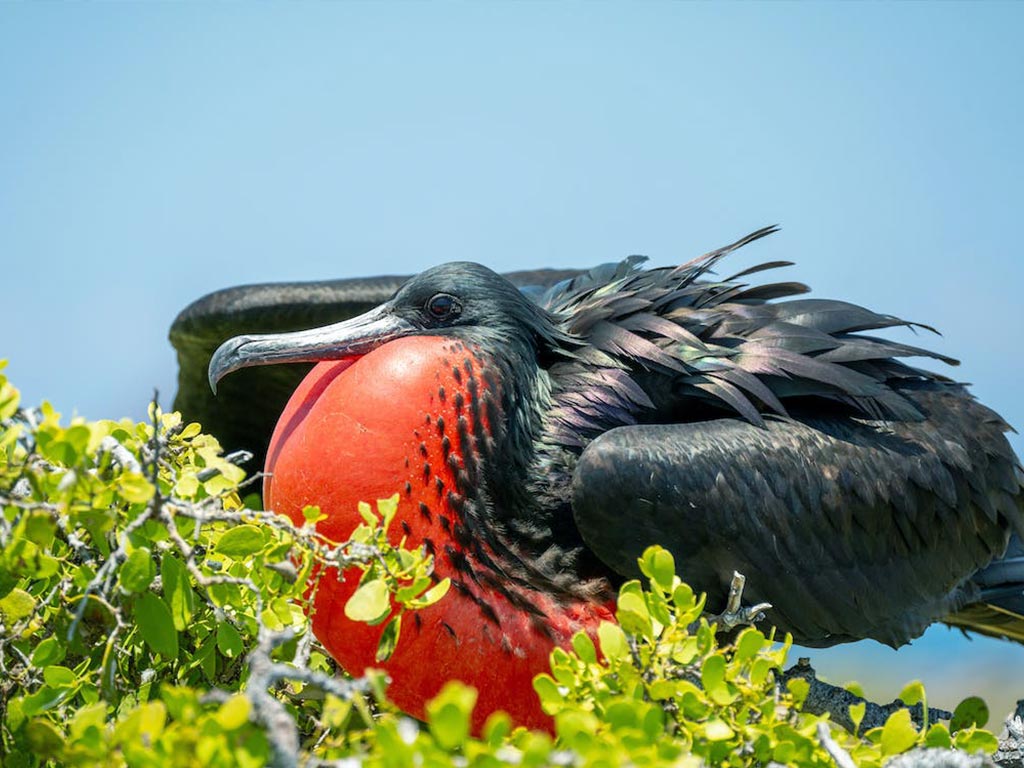
The magnificent frigatebird is the largest species of seabird in the family Fregatidae. It measures 89–114 centimeters in length and has an impressive wingspan of 2.17–2.44 meters. With its streamlined body and long, pointed wings, it is an impressive sight in the sky.
It can soar for hours without flapping its wings, taking advantage of the rising thermals created by the sun to stay high in the air. Its long, pointed wings are perfect for gliding, and the bird can cover large distances in search of food.
The most distinctive feature of the magnificent frigatebird is the red gular pouch that the male inflates to attract a mate. It is a truly majestic bird that can be found in the tropical and subtropical oceans around the world.
| Kingdom | Animalia |
| Phylum | Chordata |
| Class | Aves |
| Order | Suliformes |
| Family | Fregatidae |
| Genus | Fregata |
| Species | F. magnificens |
14. Highland Guan
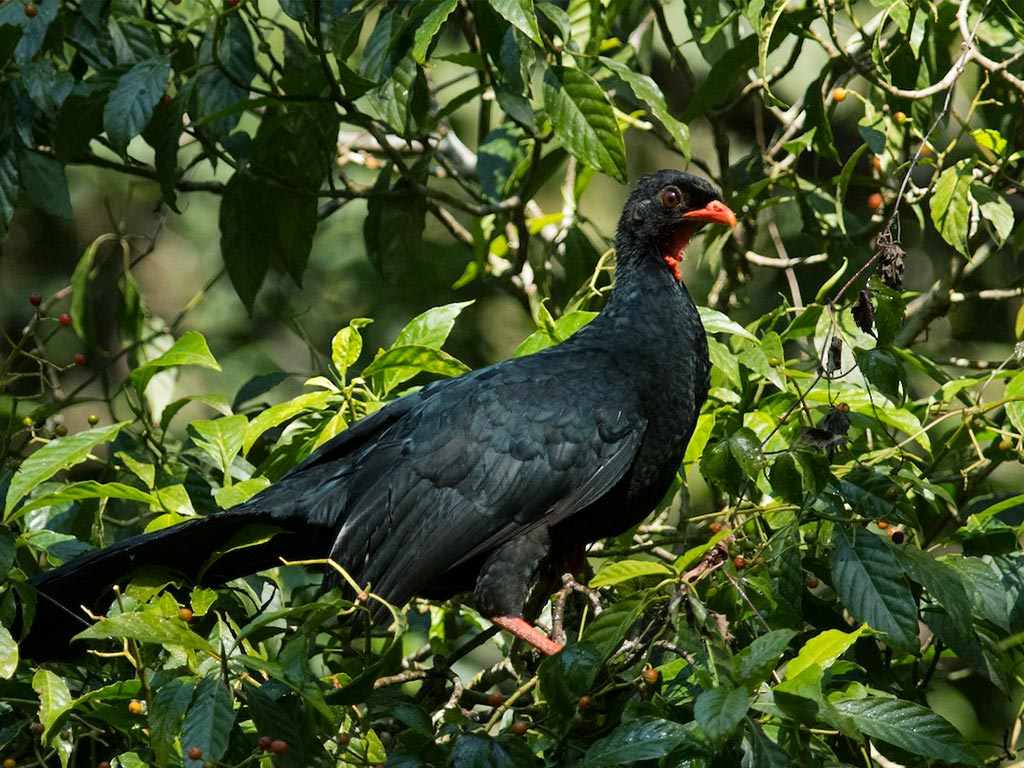
The highland guan is a rare species of bird found predominantly in Central America. It is a member of the Cracidae family of birds, which includes birds such as turkeys, guans, and chachalacas.
This particular species of guan is found mostly in the highlands of El Salvador, Guatemala, Honduras, Southern Mexico, and Nicaragua. It is a very specialized bird, only found in a few very specific habitats, such as subtropical or tropical moist montane forests.
This type of habitat is characterized by high elevations and dense vegetation, providing the highland guan with plenty of food to sustain itself. The highland guan is an important species in its own right, but it also serves as a keystone species in its natural habitat.
By helping maintain the health of its environment, it also helps to sustain other species that live in the same area.
| Kingdom | Animalia |
| Phylum | Chordata |
| Class | Aves |
| Order | Galliformes |
| Family | Cracidae |
| Genus | Penelopina |
| Species | P. nigra |
15. Lesser Nighthawk
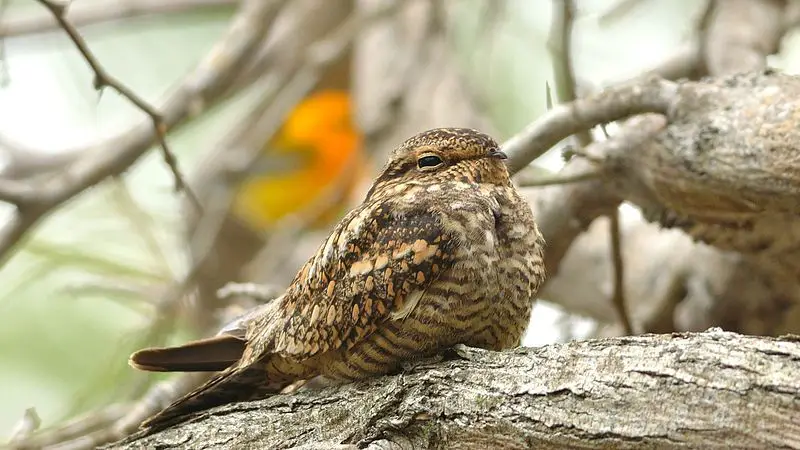
The Lesser Nighthawk is a type of nightjar, a species of bird found throughout much of the Americas. Adults of this species have dark feathers on the upperparts and breast, with a pattern of brown, grey, and white mixed in.
The wings are especially long and have a striking black color, with a white bar visible when in flight. They have a distinct, long-winged silhouette, with a broad head and short tail.
Their flight is strong and direct, and they are often seen hovering in one spot before diving to catch their prey. They are typically found in open areas, such as grasslands and savannas, with low vegetation.
They are mainly active at night and are known to make a distinctive ‘peent’ call, which is especially loud near sunrise and sunset.
| Kingdom | Animalia |
| Phylum | Chordata |
| Class | Aves |
| Clade | Strisores |
| Order | Caprimulgiformes |
| Family | Caprimulgidae |
| Genus | Chordeiles |
| Species | C. acutipennis |
16. Gray-headed Dove
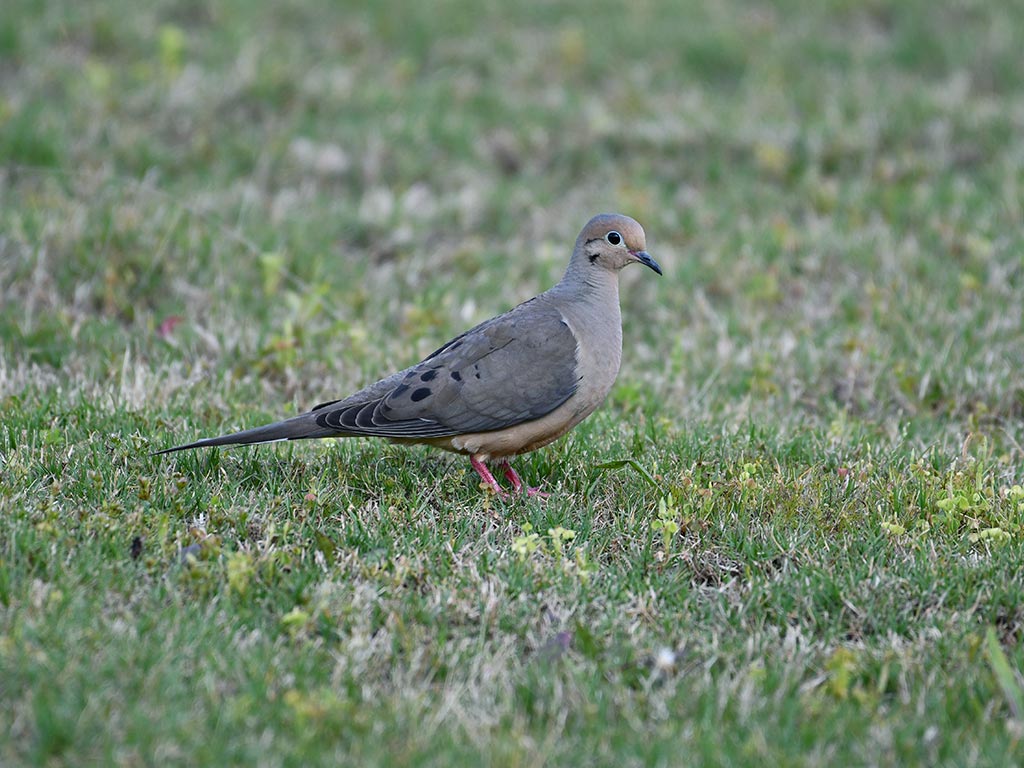
The grey-headed dove is a species of large New World dove, belonging to the genus Leptotila. It is a medium-sized dove, measuring around 16 inches in length, with a grey head and neck, and a brown body and wings.
The grey-headed dove is found throughout a large range of habitats in Central and South America, from eastern Mexico down to Colombia. It prefers tropical and subtropical forests, as well as woodlands, shrublands, and grasslands.
It is largely a terrestrial species but may take to the air to find food or escape from predators. The grey-headed dove is a gregarious species, often seen in small to large groups in open habitats.
Its diet consists mainly of seeds and fruits, which it forages for on the ground. It is usually seen perched on branches or wires and is known to be a very vocal species, producing a variety of cooing calls.
It is also known to be quite a skittish species, often taking flight at the slightest disturbance. The grey-headed dove is a monogamous species, usually forming pairs during the breeding season. Its nest is a shallow platform of twigs, built high up in the trees.
The female usually lays two white eggs, which are incubated for around 14 days. The chicks fledge after another 14 days and remain in the care of the parents for some time afterward. The grey-headed dove is not considered to be threatened, and its population is stable.
It is listed as Least Concern on the IUCN Red List.
| Kingdom | Animalia |
| Phylum | Chordata |
| Class | Aves |
| Order | Columbiformes |
| Family | Columbidae |
| Genus | Leptotila |
| Species | L. plumbeiceps |
17. Great Potoo
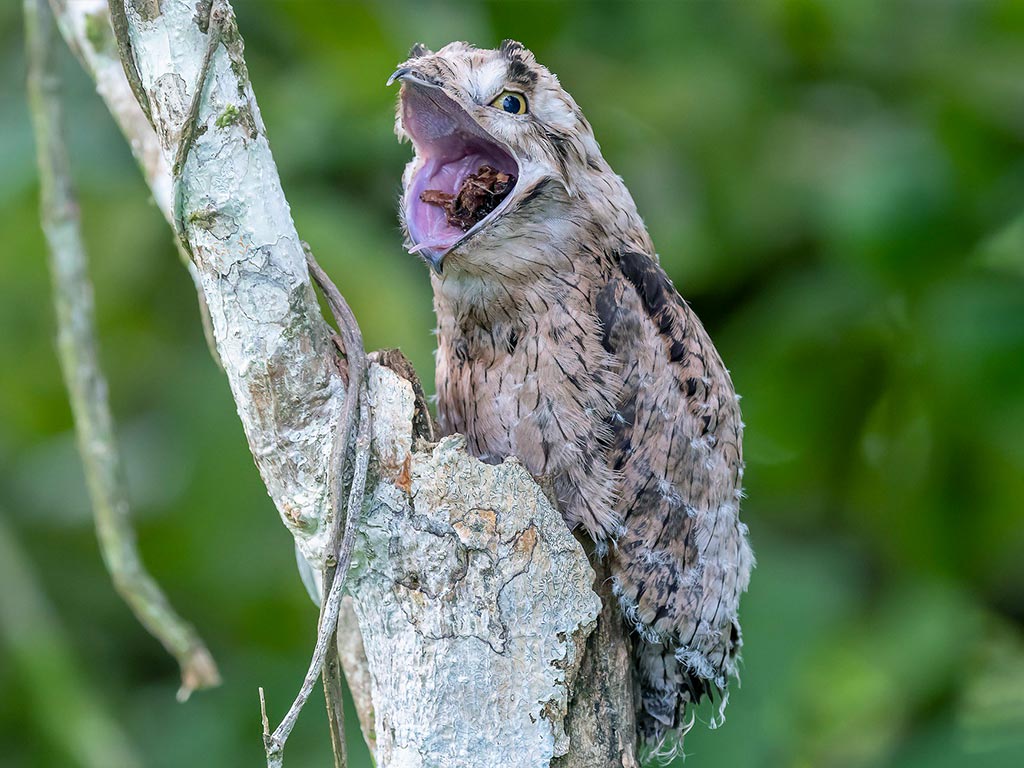
The Great Potoo is a species of bird that is native to Central and South America and is the largest species of potoo. It is a nocturnal creature, meaning that it is active at night and sleeps during the day.
This bird is similar to owls in that it hunts by sitting on a high perch and waiting for its prey, then swooping down and catching it with its beak. Its diet consists of large insects and small vertebrates, such as lizards and frogs.
The Great Potoo is a solitary species, and while it may occasionally be seen in pairs or small family groups, it usually lives alone.
In addition to being a masterful hunter, the Great Potoo also has excellent camouflage, blending in with its surroundings during the day and becoming almost invisible. Its large eyes and ears allow it to detect and capture its prey with ease.
| Kingdom | Animalia |
| Phylum | Chordata |
| Class | Aves |
| Clade | Strisores |
| Order | Nyctibiiformes |
| Family | Nyctibiidae |
| Genus | Nyctibius |
| Species | N. grandis |
18. Violet Sabrewing
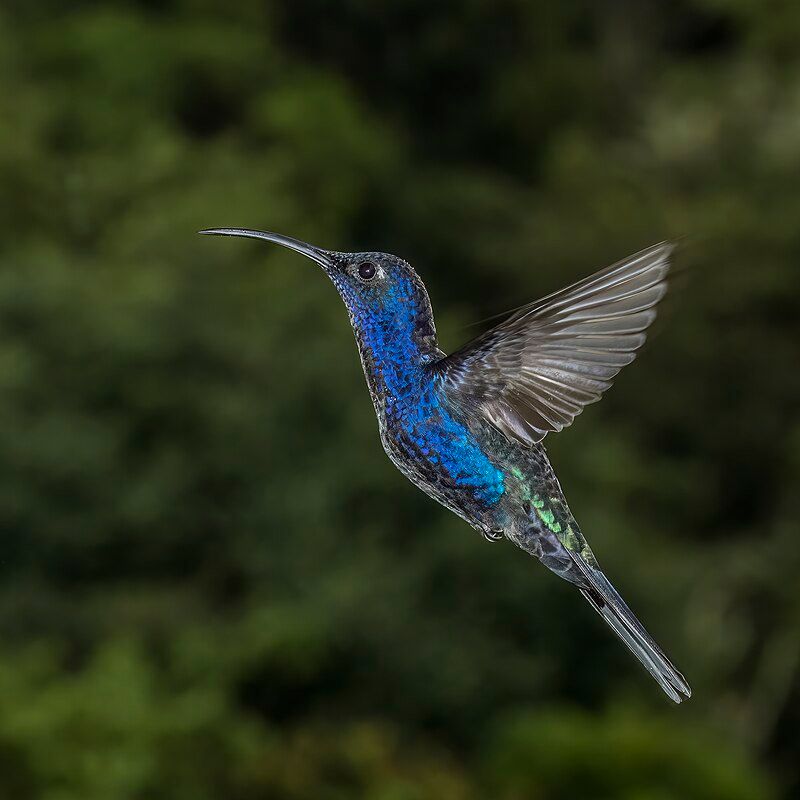
The violet brewing is a species of hummingbird that belongs to the Trochilini tribe of the Trochilinae subfamily. The hummingbird species is native to the Americas, as it is found from Mexico to Panama.
The Trochilini tribe is part of the larger emeralds group, which includes around 50 hummingbird species. The violet sabrewing is usually found living in tropical and subtropical lowland forests. It has a long, curved bill that is used to reach deep into flowers for nectar.
It is a small bird, with an average length of around 10 cm. It has vibrant, iridescent plumage which is a mix of violet, green, and blue. This species is considered to be common in its range, however, it is threatened by human activities such as deforestation and climate change.
| Kingdom | Animalia |
| Phylum | Chordata |
| Class | Aves |
| Clade | Strisores |
| Order | Apodiformes |
| Family | Trochilidae |
| Genus | Campylopterus |
| Species | C. hemileucurus |
19. Turkey Vulture
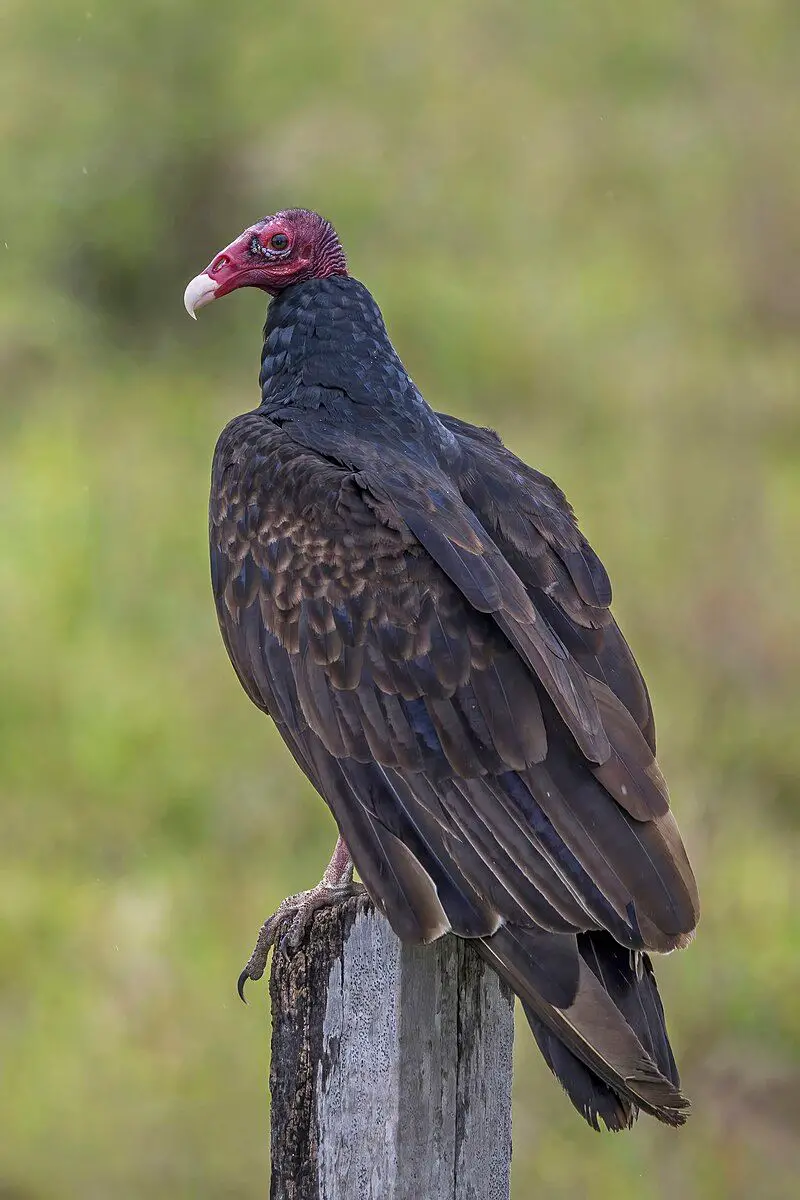
The turkey vulture is a species of bird found commonly throughout the Americas. It belongs to the genus Cathartes and family Cathartidae, which are both specific to the New World. It is the most widespread of all the New World vultures, inhabiting both North and South America.
Its range extends from southern Canada down to the southernmost tip of South America. The turkey vulture is a large bird with a wingspan of up to 6.5 feet. Its body is mostly black with a featherless red head and a white stripe along the wings.
It has a curved bill and a strong, hooked beak. Turkey vultures are scavengers and feed primarily on carrion. Turkey vultures are social birds, often gathering in groups to roost and feed.
They are also gregarious when migrating, flying in large flocks that can reach up to 1,000 birds.
These flocks usually travel during the day, soaring high in the sky. Turkey vultures play an important role in the environment by helping to clean up animal carcasses and dispose of waste.
They are also beneficial to other species, as their presence may discourage large predators from approaching a carcass. The turkey vulture is an iconic species in the Americas, representing a unique and important part of the region’s ecosystems.
It is an impressive bird that has a wide range of adaptations to survive in its habitat. Its importance to the environment and its remarkable presence make it a well-loved species.
| Kingdom | Animalia |
| Phylum | Chordata |
| Class | Aves |
| Order | Accipitriformes |
| Family | Cathartidae |
| Genus | Cathartes |
| Species | C. aura |
20. Double-crested Cormorant
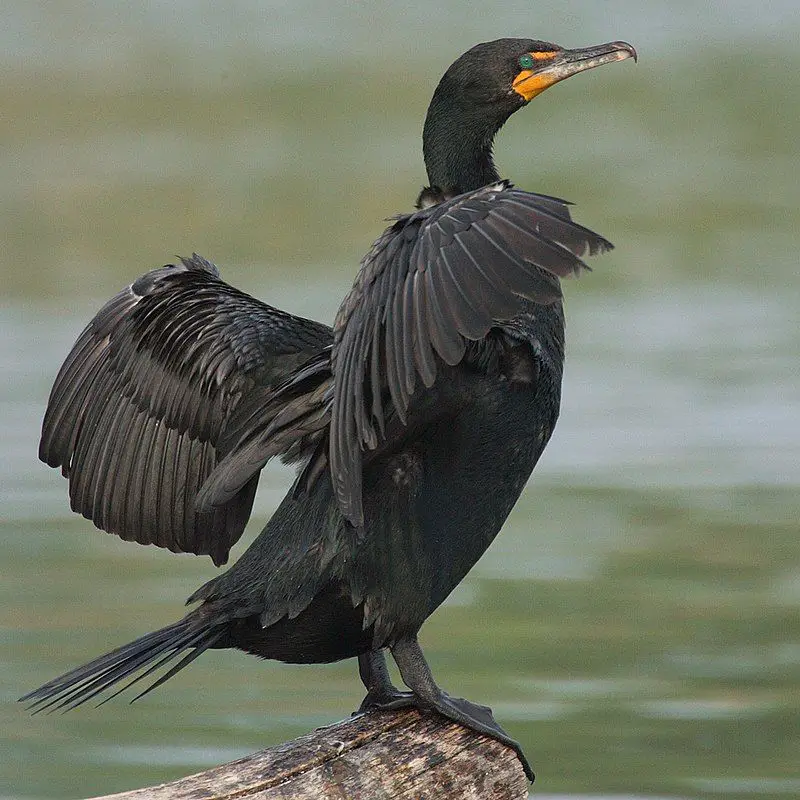
The double-crested cormorant is a species of water bird that belongs to the cormorant family. It is a fairly common bird and can be found in a variety of habitats. It is most commonly seen near rivers, lakes, and coastal areas.
Its range is vast, stretching from the Aleutian Islands in Alaska to Florida and Mexico. The double-crested cormorant is an excellent swimmer and can often be seen floating on the surface of the water.
It has a long, slender neck and a pointed bill that it uses to search for food. It primarily feeds on small fish, crustaceans, and mollusks. Its feathers are mostly black or dark gray, with a white patch on its neck and chest.
The double-crested cormorant is a social bird and often nests in colonies. Its nest is usually a simple platform of sticks and twigs, which it builds in the trees near the water.
It is considered an important species in the ecosystem, as it helps to control the populations of fish and other aquatic creatures. Overall, the double-crested cormorant is an important species that is widely distributed across North America.
Its wide range and remarkable adaptability make it an interesting and important species to observe and learn about.
| Kingdom | Animalia |
| Phylum | Chordata |
| Class | Aves |
| Order | Suliformes |
| Family | Phalacrocoracidae |
| Genus | Nannopterum |
| Species | N. auritum |
Conclusion
Birds are an important part of the ecosystem in Quetzaltenango. They play a vital role in pollination and provide food for other species. The birds in Quetzaltenango provide a great source of beauty and entertainment for locals and visitors alike.
The various species of birds in the area add to the unique biodiversity of the region. Therefore, it is important to protect the birds and their habitats to maintain the health and beauty of Quetzaltenango.